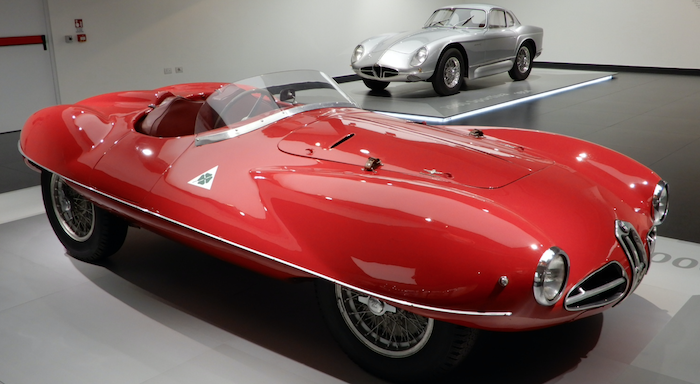The subject is the 1952 Alfa Romeo 1900 C52 Disco Volante, spider version (Wikipedia entry here). Disco Volante is transated literally from the Italian as "flying disk," but sources in English use "flying saucer." That was what the Italians meant, because flying saucers were a new, interesting, popular Thing starting in 1947 when one was claimed to have been spotted near Mt. Rainier in Washington state.
All that said, the Disco Volante was a distinctive design that is still remebered by car fans and perhaps even some of the general public.
According to the link above, the project was the development of a racing car with advanced aerodynamic shaping. For example, the underside of the car was cladded apart for areas cleared for functional reasons. The most unusual feature was that the sides of the car were curved so as to reduce the stability impact of cross-winds. This resulted in the car being unusually wide, proportionally.
Although Alfa Romeo had the design wind tunnel tested, some styling details and the construction of the cars were by the well-known Touring carrozzeria. The lead stylist likely being Carlo Felice Bianchi Anderloni (1916-2003), son of Felice Bianchi Anderloni, the firm's founder who died in June of 1948.
The 1952 spiders were small, with a wheelbase of 87.4 inches (2220 mm). But when photographed alone, they appeared to be larger. Images in the Gallery below probably are mostly via Alfa Romeo, though the final three were taken by me at the Alfa Romeo museum near Milano in 2019.
The hoodline tapers towards the front, but front fenders are bulged to accommodate front wheel vertical movement. Rear fender bulges are not functional in that respect.
This frontal view illustrates the side overhang.
Rear view of a Disco being tested. The strakes behind the seats are more decorative than functional.
This side view shows that even the front fenders are taller than needed for dealing with wheel jounce. This probably degraded aerodynamic efficiency to some degree, but improved the aesthetics.
The driver provides scale, helping show that Discos were not large cars.
The tail end of the car has a space for a license plate. Surrounding details are more styling by Touring than wind tunnel shaping. Any attempt to add front and rear bumpers and other street-legal features would have degraded the design considerably.








No comments:
Post a Comment